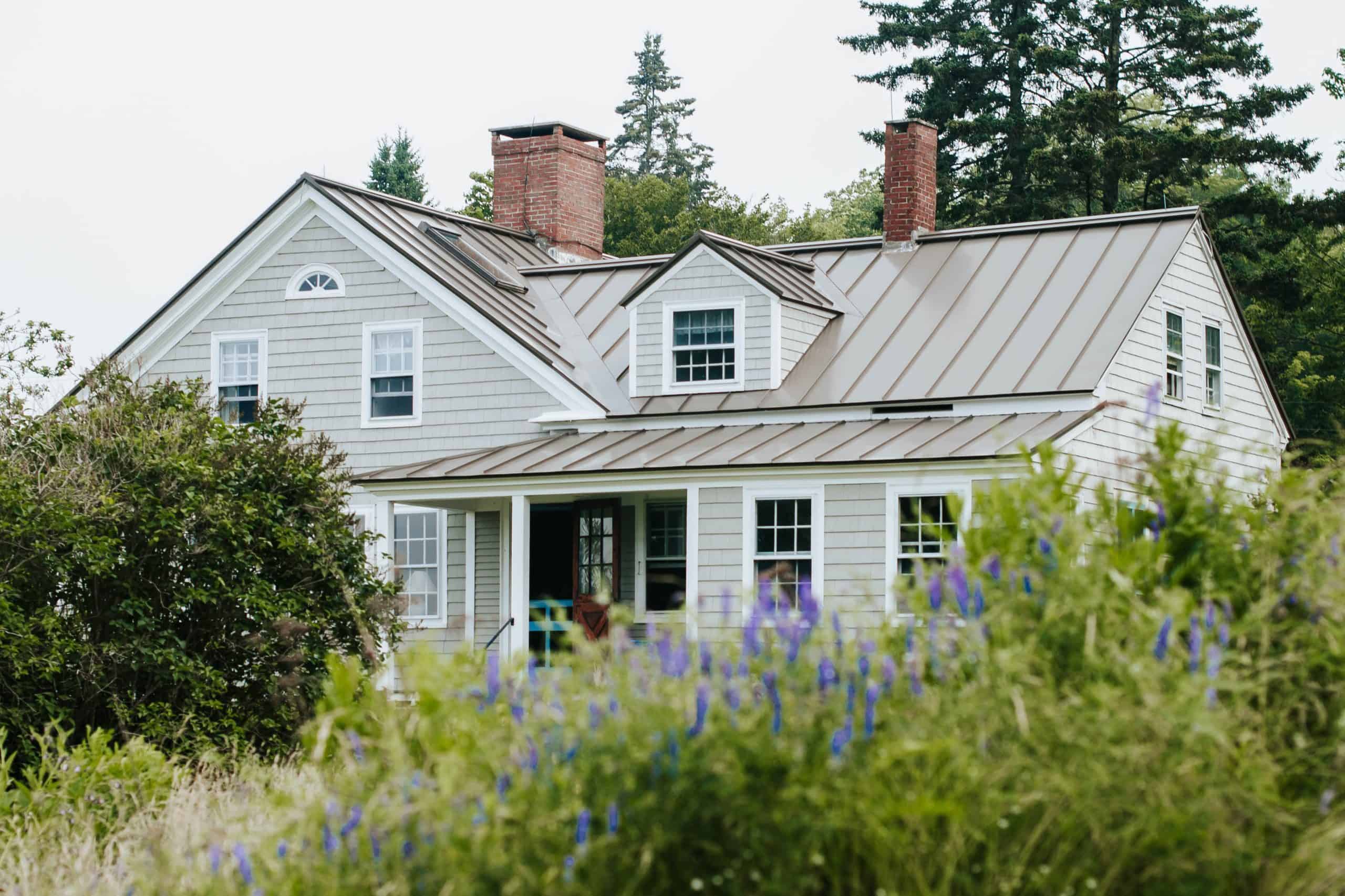A poorly ventilated home is an unhealthy home. Lack of proper ventilation can cause a range of issues, including mold and mildew, and damage to your home’s structure. A ridge vent runs along the highest point, or ridge, of your roof and is designed to help ventilate your home and keep it healthy.
Below we discuss what a ridge vent is, what it does, how it works, and how to install one.
What Is a Ridge Vent?
As the name suggests, a roof ridge vent is a vent that runs across the entire length of the rooftop of your home. You can think of this non-mechanical vent as a mini-roof, raised about three inches above the peak, or ridge, of your roof with a slit in the space between this gap.
To create a vent for heat and moisture to escape, the cap of the ridge is slightly elevated above the main roof surface creating a gap for air to escape without allowing water or debris in.
For a ridge vent to work properly, it needs to be coupled with soffit vents on both of the lowest sides of the edge of the roof. While local governments enforce the use of ridge vents by code in many areas of the United States, many homeowners prefer this ventilation system anyway because of its performance and ability to blend in with the roof.
What Does a Ridge Vent Do?
The function of ridge vents is no different from other types of roof vents. The idea is to allow the hot air and moisture to escape from the space between the trusses of the roof or attic, improving the attic’s ventilation. That’s why when we are inspecting a home, part of our home inspection checklist is to check the roof to be sure the roof is in good shape and not aging prematurely due to improper installation or lack of ventilation. But having only an exit vent makes little sense — and this is where soffit vents come into the picture.
How Do Ridge Vents Let Hot Air Escape?
Soffit vents are air intake vents. These vents are installed on the underside of the lowest portion of the roofline and allow fresh air to move in under the roof deck to help push the moist, warm air out of the attic from the top. The positive airflow guarantees proper attic ventilation, keeping your roof as close to the outdoor temperature as possible.
What are the Benefits of a Ridge Vent?
Besides making your home a better place to live in, ridge roof vents extend the life of the shingles, lower cooling costs, and prevent ice damming.
How are Roof Ridge Vents Installed?
The sheathing on your roof is cut back by between two and four inches on both sides of the ridge of your roof. Then the ridge vent system is installed, covering the hole across the length of the roof and preventing water and pests from entering your home.
What Kinds of Ridge Vents Are There?
Based on how the ridge vent covers the gap that’s cut open, ridge vents are of two types.
Shingle Over Ridge Vents
Installed over the gap in the ridge, these vents blend into the roof since they are hidden away under the asphalt cap shingles installed over them.
Aluminum Ridge Vents
Installed just like the shingle over vents, the cap shingles are not installed over aluminum ridge vents. They have a mushroom-like shape and a broad flange on both sides. These vents cannot be hidden, and their look doesn’t suit every home, so make sure you are firm in your decision if you choose to install this metal ridge vent.
Ridge vents may also be classified based on active ventilation and passive ventilation. Active ventilation systems are coupled with ridge vents that have baffles, which are “chutes” installed on the inside of the roof decking that enable airflow from the soffit vents to the ridge vent.
On the other hand, passive ventilation systems are coupled with ridge vents without baffles. The obvious downside of this type of vent is the compromise on cooling. However, ridge vents without a baffle also leave a gap open for the elements to enter your home. In other words, you can expect debris and insects from the outdoors to make their way into your home if you don’t install a screen.
While both ridge vents do the job, if you live in a location with heavy rains, installing a ridge without a baffle is a no-no. Ridge vents with a baffle are the superior and more sensible option for keeping water out, regardless of where you live.
Should You Replace Your Roof Vents with a Ridge Vent?
If you’ve found this article, chances are, your home already has turtle vents, box vents, or gable vents. You may be questioning the necessity of installing a ridge vent.
Other Types of Roof Vents
Not sure what kind of roof vent you currently have? Here are brief descriptions of the aforementioned ventilation systems.
Box vents
These are square holes in your roof that are paired with soffit vents to allow hot air to escape. Homes typically have a handful of these, depending on the size of the roof. You can easily spot these vents from the ground.
Turtle vents
Resembling turtle shells, these vents have a distinctive curved design. When not used with soffit vents, these non-mechanical vents only let out the hot air from where they are installed.
Gable vents
Installed either on the front or the sides of a home, you will find these rectangular vents below the roof ridge. Like the other two vents, these vents are ineffective without a soffit vent.
Why is a Ridge Vent Better?
Roof ridge vents work better than the three vents mentioned above for two main reasons:
- They have a continuous design.
- They are installed at the very top of your roof.
Providing an outlet where the hottest air is, ridge vents ventilate homes better than multiple gable or box vents can. Furthermore, you only need to install one ridge vent on the highest ridge of the roof to get the job done. Since ridge vents are non-mechanical, there is no need for an electrical system, either.
Any ventilation consultant will tell you that having roof vents of any kind is better than having no vents. However, ridge vents stand out as efficient, cost-effective solutions to ventilating your home.
If you’re installing a new roof, the answer is a definite yes, since a ridge vent will extend the life of the roof. But there is no harm in installing a ridge vent even if you aren’t replacing your roof since the ventilation system will prolong the life of your current roof just as well.
Ridge vents are known to work best on shingled roofs, but you can have them installed on metal roofs.
Does a Ridge Vent Provide Enough Ventilation?
Roofing manufacturers typically require a home to have one square foot of ventilation per 150 square feet of attic space — except when ridge vents are installed, they only require one square foot of ventilation per 300 square feet. Check out this attic ventilation calculator to learn more.
This industry standard is a reliable indicator of the excellent ventilation that ridge vents facilitate. Of course, these vents aren’t very effective by themselves and are typically installed alongside soffit vents. However, you can also choose to install gable vents for air intake — since it is only essential that cold air moves into the attic to create the required air pressure to push the hot air out.
Do Ridge Vents Work In the Winter?
The reasons for installing vents are different in different climates. In cold climates, attic ventilation is required to keep the roof cool. A properly ventilated roof reduces the chances of ice dams forming. Additionally, it helps get rid of the moisture that gets trapped in the attic when it moves upwards from the living space.
Regardless of whether you live in a hot or cold climate, ridge vents work the same way, and are installed in the same way.
What Happens if Snow Blocks Ridge Vents?
Like any vent, if snow covers a ridge vent and blocks it, the vent will not function correctly, since there is no room for the air to escape.
If snow builds up, the vent will stop working, but since ridge vents are at the highest point of the roof when the wind blows and the sun shines, the vents will quickly get unblocked. Furthermore, when it snows heavily, warmer air in the attic still works its way to the top, often melting off the snow covering the vent.
That being said, ridge vents are not ice-dam-proof. There is nothing you can do about this except wait for the ice to melt, and the moisture to expel naturally.
Do Ridge Vents Work in the Summer?
The roofs of homes in hot climates get extremely hot with the sun battering them with heat. The resulting super-heated air in the attic brings up the temperature of the entire home, making cooling the home that much more expensive.
The arrival of hot months also induces excess moisture build-up, which is worsened by mechanical equipment sweating.
The purpose of installing a ridge vent in a hot climate is to circulate the hot, humid air to the outside and draw the cool air inside. This circulation leads to a significant decrease in cooling costs by reducing the power needed by the air conditioning system to maintain the desired temperature.
Is Installing a Ridge Vent Worth It?
Many homeowners are unaware that a hot attic can damage the roof shingles, and this damage is generally not covered under the warranty. Even if your roof shingles don’t get damaged from the heat, you can still expect them to not last as long as you’d expect them to without a venting system.
Preventing this damage is quite simple and cheap with a ridge vent system, so much so that it doesn’t make sense not to install it. It’s certainly a worthwhile investment.
Most ventilation professionals will agree that the money you save on roof repairs, coupled with the energy savings, amounts to more than the cost of a ridge vent.
One thing you can be sure of is that ridge vents are much more effective than turbine vents and other attic vents, granted they are paired with functioning intake vents.


